0.前言
在开发物联网过程中,会遇到OTA固件升级等功能。对于服务器来说,其实就很简单的一个功能,无非就是一个上传文件,保存,下载文件的功能而已。在此之前,我也通过简单的文件系统实现文件上传下载。然后把路径保存到数据。也有人使用阿里的OSS来管理。但是今天要讲的就是搭建一个开源版本的OSS存储服务器。
1.安装MinIO
流程的话,参考官方文档,https://docs.min.io/cn/minio-quickstart-guide.html,由于使用go语言开发的,整个过程还是比较轻松简单的。这里我使用docker来运行MinIO。下面这个图,是我搭建的架构图。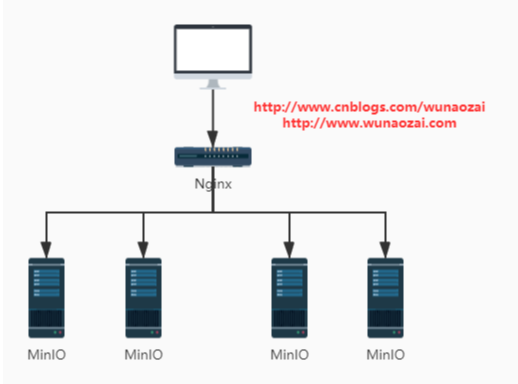
这里,默认读者是已经安装过Docker和docker-compose的。下面提供docker-compose.yml
可以直接从这里下载:https://raw.githubusercontent.com/minio/minio/master/docs/orchestration/docker-compose/docker-compose.yaml
1 version: '3.7' 2 3 # starts 4 docker containers running minio server instances. Each 4 # minio server's web interface will be accessible on the host at port 5 # 9001 through 9004. 6 services: 7 minio1: 8 image: minio/minio:RELEASE.2019-12-24T23-04-45Z 9 volumes: 10 - data1-1:/data1 11 - data1-2:/data2 12 ports: 13 - "9001:9000" 14 environment: 15 MINIO_ACCESS_KEY: minio 16 MINIO_SECRET_KEY: minio123 17 command: server http://minio{1...4}/data{1...2} 18 healthcheck: 19 test: ["CMD", "curl", "-f", "http://localhost:9000/minio/health/live"] 20 interval: 30s 21 timeout: 20s 22 retries: 3 23 24 minio2: 25 image: minio/minio:RELEASE.2019-12-24T23-04-45Z 26 volumes: 27 - data2-1:/data1 28 - data2-2:/data2 29 ports: 30 - "9002:9000" 31 environment: 32 MINIO_ACCESS_KEY: minio 33 MINIO_SECRET_KEY: minio123 34 command: server http://minio{1...4}/data{1...2} 35 healthcheck: 36 test: ["CMD", "curl", "-f", "http://localhost:9000/minio/health/live"] 37 interval: 30s 38 timeout: 20s 39 retries: 3 40 41 minio3: 42 image: minio/minio:RELEASE.2019-12-24T23-04-45Z 43 volumes: 44 - data3-1:/data1 45 - data3-2:/data2 46 ports: 47 - "9003:9000" 48 environment: 49 MINIO_ACCESS_KEY: minio 50 MINIO_SECRET_KEY: minio123 51 command: server http://minio{1...4}/data{1...2} 52 healthcheck: 53 test: ["CMD", "curl", "-f", "http://localhost:9000/minio/health/live"] 54 interval: 30s 55 timeout: 20s 56 retries: 3 57 58 minio4: 59 image: minio/minio:RELEASE.2019-12-24T23-04-45Z 60 volumes: 61 - data4-1:/data1 62 - data4-2:/data2 63 ports: 64 - "9004:9000" 65 environment: 66 MINIO_ACCESS_KEY: minio 67 MINIO_SECRET_KEY: minio123 68 command: server http://minio{1...4}/data{1...2} 69 healthcheck: 70 test: ["CMD", "curl", "-f", "http://localhost:9000/minio/health/live"] 71 interval: 30s 72 timeout: 20s 73 retries: 3 74 75 ## By default this config uses default local driver, 76 ## For custom volumes replace with volume driver configuration. 77 volumes: 78 data1-1: 79 data1-2: 80 data2-1: 81 data2-2: 82 data3-1: 83 data3-2: 84 data4-1: 85 data4-2:
docker-compose up 启动服务
通过浏览器访问如下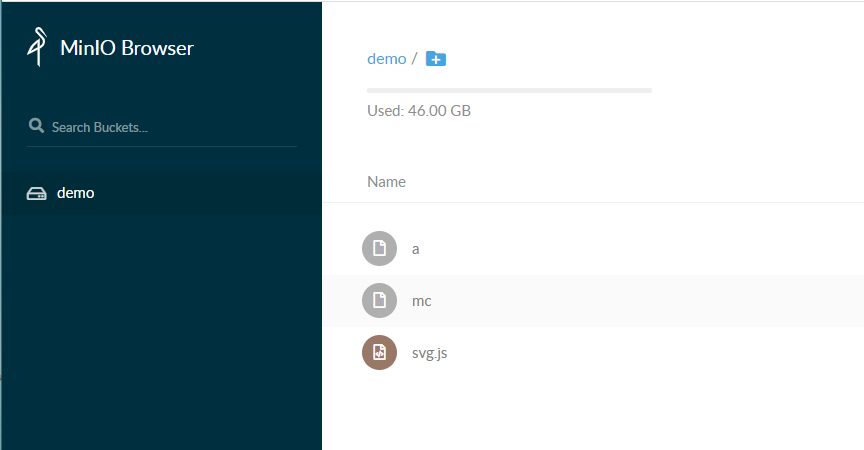
2.Nginx负载均衡
从上面可以看到,是启动了4个服务,这里可以理解是有4台minio服务器。这里配置一台Nginx作为前端负载均衡,nginx配置如下:
1 upstream minio-server{ 2 #默认负载均衡策略有四种 3 #1. 默认不设置,采用轮询 4 #2. least_conn 最少连接负载均衡 5 #3. ip_hash 会话持久化负载均衡 6 #4. server 127.0.0.1 weight=1 带权重负载均衡 7 least_conn; 8 #ip_hash; 9 10 server 127.0.0.1:9001 weight=10; 11 server 127.0.0.1:9002 weight=10; 12 server 127.0.0.1:9003 weight=10; 13 server 127.0.0.1:9004 weight=10; 14 } 15 16 server { 17 listen 81 default_server; 18 listen [::]:81 default_server; 19 20 server_name _; 21 22 location / { 23 proxy_set_header Host $http_host; #注意这里的Header一定要带到Minio,否则认证不通过 24 add_header X-Host 'MinIO from $upstream_addr'; 25 proxy_pass http://minio-server; 26 } 27 }
配置nginx.conf后,reload配置,访问资源,可以根据X-Host字段判断,Nginx是有进行负载均衡,每次分配到不同的机器上。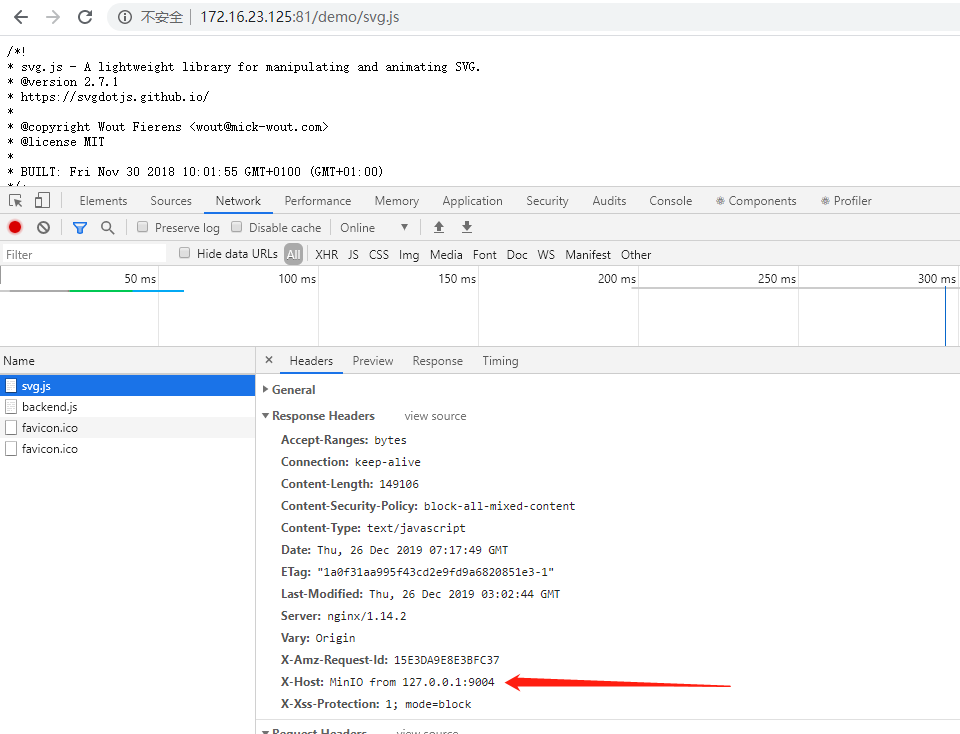
3.MinIO使用
Web端访问,在Web端,创建一个Demo的Bucket。然后就可以web端上传下载文件。默认Bucket是有策略(Policy)的权限控制。
可以在Web端修改策略为ReadOnly,这样就可以通过链接URL直接访问资源。类似图床的做法。
4.Java Client(基于SpringBoot)
MinIO的客户端有很多种,也支持很多编程语言,官方有个mc工具https://docs.min.io/cn/minio-client-quickstart-guide.html
下面主要讲使用Java语言如何接入服务器。参考:https://docs.min.io/cn/java-client-quickstart-guide.html
完整代码如下:
pom.xml
1 <?xml version="1.0" encoding="UTF-8"?> 2 <project xmlns="http://maven.apache.org/POM/4.0.0" xmlns:xsi="http://www.w3.org/2001/XMLSchema-instance" 3 xsi:schemaLocation="http://maven.apache.org/POM/4.0.0 https://maven.apache.org/xsd/maven-4.0.0.xsd"> 4 <modelVersion>4.0.0</modelVersion> 5 <parent> 6 <groupId>org.springframework.boot</groupId> 7 <artifactId>spring-boot-starter-parent</artifactId> 8 <version>2.2.2.RELEASE</version> 9 <relativePath/> <!-- lookup parent from repository --> 10 </parent> 11 <groupId>com.wunaozai.demo</groupId> 12 <artifactId>WunaozaiDemo</artifactId> 13 <version>0.0.1-SNAPSHOT</version> 14 <name>JWunaozaiDemo</name> 15 <description>所有测试例子</description> 16 17 <properties> 18 <java.version>1.8</java.version> 19 <maven-jar-plugin.version>3.0.0</maven-jar-plugin.version> 20 </properties> 21 22 <dependencies> 23 <dependency> 24 <groupId>org.springframework.boot</groupId> 25 <artifactId>spring-boot-starter</artifactId> 26 </dependency> 27 <dependency> 28 <groupId>org.springframework.boot</groupId> 29 <artifactId>spring-boot-starter-web</artifactId> 30 </dependency> 31 <dependency> 32 <groupId>org.springframework.boot</groupId> 33 <artifactId>spring-boot-configuration-processor</artifactId> 34 <optional>true</optional> 35 </dependency> 36 37 <!-- MinIO Client --> 38 <dependency> 39 <groupId>io.minio</groupId> 40 <artifactId>minio</artifactId> 41 <version>6.0.11</version> 42 </dependency> 43 <!-- 文件上传 --> 44 <dependency> 45 <groupId>commons-fileupload</groupId> 46 <artifactId>commons-fileupload</artifactId> 47 <version>1.3.3</version> 48 </dependency> 49 50 <dependency> 51 <groupId>org.springframework.boot</groupId> 52 <artifactId>spring-boot-starter-test</artifactId> 53 <scope>test</scope> 54 </dependency> 55 </dependencies> 56 57 <build> 58 <plugins> 59 <plugin> 60 <groupId>org.springframework.boot</groupId> 61 <artifactId>spring-boot-maven-plugin</artifactId> 62 </plugin> 63 </plugins> 64 </build> 65 66 </project>
application.properties
1 #MinIO 2 minio.url=http://172.16.23.125:81 3 minio.access-key=minio 4 minio.secret-key=minio123 5 minio.bucket-name=demo
MinIOProperties.java
1 package com.wunaozai.demo.minio; 2 3 import org.springframework.boot.context.properties.ConfigurationProperties; 4 5 /** 6 * 注入配置到properties 7 * @author wunaozai 8 * @Date 2019-12-26 9 */ 10 @ConfigurationProperties(prefix="minio") 11 public class MinIOProperties { 12 /** 13 * Minio 服务地址 14 */ 15 private String url; 16 /** 17 * Access Key 18 */ 19 private String accessKey; 20 /** 21 * Secret Key 22 */ 23 private String secretKey; 24 /** 25 * Bucket 26 */ 27 private String bucketName; 28 public String getUrl() { 29 return url; 30 } 31 32 public void setUrl(String url) { 33 this.url = url; 34 } 35 36 public String getAccessKey() { 37 return accessKey; 38 } 39 40 public void setAccessKey(String accessKey) { 41 this.accessKey = accessKey; 42 } 43 44 public String getSecretKey() { 45 return secretKey; 46 } 47 48 public void setSecretKey(String secretKey) { 49 this.secretKey = secretKey; 50 } 51 52 public String getBucketName() { 53 return bucketName; 54 } 55 56 public void setBucketName(String bucketName) { 57 this.bucketName = bucketName; 58 } 59 60 }
MinIOAutoConfiguration.java
1 package com.wunaozai.demo.minio; 2 3 import org.springframework.boot.context.properties.EnableConfigurationProperties; 4 import org.springframework.context.annotation.Configuration; 5 6 /** 7 * 初始化MinioClient 并自动注入到spring容器(Bean) 8 * @author wunaozai 9 * @Date 2019-12-26 10 */ 11 @Configuration 12 @EnableConfigurationProperties({MinIOProperties.class}) 13 public class MinIOAutoConfiguration { 14 15 }
MinIOTemplate.java
1 package com.wunaozai.demo.minio; 2 3 import java.io.InputStream; 4 5 import org.springframework.beans.factory.InitializingBean; 6 import org.springframework.beans.factory.annotation.Autowired; 7 import org.springframework.stereotype.Component; 8 import org.springframework.util.Assert; 9 10 import io.minio.MinioClient; 11 import io.minio.ObjectStat; 12 13 /** 14 * 抽象模版类 15 * @author wunaozai 16 * @Date 2019-12-26 17 */ 18 @Component 19 public class MinioTemplate implements InitializingBean { 20 21 @Autowired 22 private MinIOProperties properties; 23 24 private MinioClient client; 25 26 public void printInfo() { 27 System.out.println(properties.getAccessKey()); 28 } 29 30 @Override 31 public void afterPropertiesSet() throws Exception { 32 Assert.hasText(properties.getUrl(), "Minio url 为空"); 33 Assert.hasText(properties.getAccessKey(), "Minio accessKey为空"); 34 Assert.hasText(properties.getSecretKey(), "Minio secretKey为空"); 35 this.client = new MinioClient( 36 properties.getUrl(), properties.getAccessKey(), properties.getSecretKey()); 37 38 } 39 40 public boolean checkBucketName(String bucketName) throws Exception { 41 return client.bucketExists(bucketName); 42 } 43 public String getObjectURL(String objectName, Integer expires) throws Exception { 44 return client.presignedGetObject(properties.getBucketName(), objectName, expires); 45 } 46 public void saveObject(String objectName, InputStream stream, long size, 47 String contentType) throws Exception { 48 client.putObject(properties.getBucketName(), 49 objectName, stream, size, null, null, contentType); 50 } 51 public ObjectStat getObjectInfo(String objectName) throws Exception { 52 return client.statObject(properties.getBucketName(), objectName); 53 } 54 public void removeObject(String objectName) throws Exception { 55 client.removeObject(properties.getBucketName(), objectName); 56 } 57 58 }
MinIORestController.java
1 package com.wunaozai.demo.minio; 2 3 import java.io.InputStream; 4 import java.util.Iterator; 5 6 import javax.servlet.http.HttpServletRequest; 7 8 import org.springframework.beans.factory.annotation.Autowired; 9 import org.springframework.web.bind.annotation.RequestMapping; 10 import org.springframework.web.bind.annotation.RestController; 11 import org.springframework.web.multipart.MultipartFile; 12 import org.springframework.web.multipart.MultipartHttpServletRequest; 13 import org.springframework.web.multipart.commons.CommonsMultipartResolver; 14 15 import io.minio.ObjectStat; 16 17 @RestController 18 @RequestMapping(value="/minio") 19 public class MinIORestController { 20 21 22 @Autowired 23 private MinioTemplate minioTemplate; 24 25 @RequestMapping(value="/checkbucketname") 26 public String checkBucketName(String name) throws Exception { 27 return minioTemplate.checkBucketName(name) + ""; 28 } 29 @RequestMapping(value="/get") 30 public String getObjectURL(String filename) throws Exception { 31 return minioTemplate.getObjectURL(filename, 2000); 32 } 33 @RequestMapping(value="/info") 34 public String getObjectInfo(String filename) throws Exception { 35 ObjectStat stat = minioTemplate.getObjectInfo(filename); 36 return stat.bucketName() + "#" + stat.name(); 37 } 38 @RequestMapping(value="/put") 39 public String putObject(HttpServletRequest request) { 40 CommonsMultipartResolver resolver = new CommonsMultipartResolver(request.getSession().getServletContext()); 41 if(!resolver.isMultipart(request)) { 42 return "error"; 43 } 44 MultipartHttpServletRequest multiRequest = (MultipartHttpServletRequest) request; 45 String filename = multiRequest.getParameter("filename"); 46 Iterator<String> it = multiRequest.getFileNames(); 47 while(it.hasNext()) { 48 try { 49 MultipartFile file = multiRequest.getFile(it.next()); 50 if(filename == null || filename.equals("")) { 51 filename = file.getOriginalFilename(); 52 } 53 long size = file.getSize(); 54 String contentType = file.getContentType(); 55 InputStream input = file.getInputStream(); 56 minioTemplate.saveObject(filename, input, size, contentType); 57 return "ok"; 58 } catch (Exception e) { 59 e.printStackTrace(); 60 } 61 } 62 return "error"; 63 64 } 65 }
基于上述代码,可以可以直接集成到项目里面。通过PostMan请求结果如下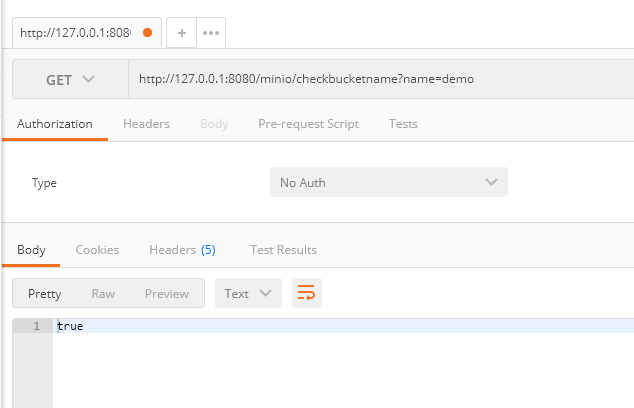
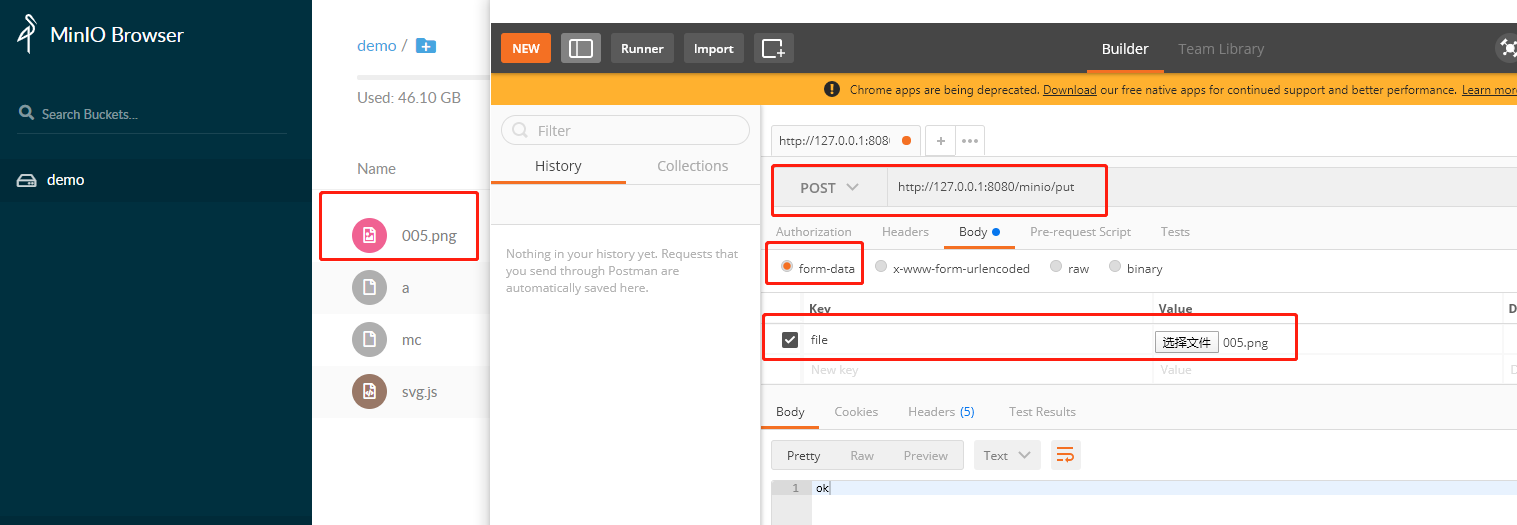
参考资料:
https://docs.min.io/cn/java-client-quickstart-guide.html
https://github.com/aboullaite/minio-starter
https://blog.csdn.net/huangbaoling66/article/details/90179736
https://www.cnblogs.com/DarrenChan/p/8967412.html
本文地址:https://www.cnblogs.com/wunaozai/p/12103949.html
本系列目录: https://www.cnblogs.com/wunaozai/p/8067577.html
个人主页:https://www.wunaozai.com/
